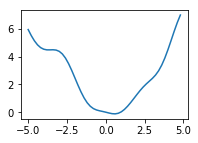Simple example of a Gaussian process¶
The following example illustrates how we move from process to distribution and also shows that the Gaussian process defines a distribution over functions.
\(f \sim \mathcal{GP}(m,k)\)
\(m(x) = \frac{x^2}{4}\)
\(k(x,x') = exp(-\frac{1}{2}(x-x')^2)\)
\(y = f + \epsilon\)
\(\epsilon \sim \mathcal{N}(0, \sigma^2)\)
In [1]:
## Importing necessary packages
import numpy as np
import matplotlib.pyplot as plt
In [2]:
## Generating x-axis of 50 linearly spaced data points
## in the range between -5 and 5.
x = np.arange(-5,5,0.2)
n = x.size
s = 1e-7 # Noise parameter for y: s = sigma^2
In [3]:
## Defining the mean function
m = np.square(x) * 0.25
In [4]:
## Defining the covariance matrix k_y with respect to x
a = np.repeat(x, n).reshape(n, n)
k_y = np.exp(-0.5*np.square(a - a.transpose())) \
+ s*np.identity(n)
In [5]:
## We sample an n-dimensional vector of function values
## for y
r = np.random.multivariate_normal(m, k_y, 1)
y = np.reshape(r, n)
In [6]:
## The missing function values are filled in smoothly
## by the matplotlib-package
plt.figure(figsize = (3,2))
plt.plot(x,y)
plt.show()
